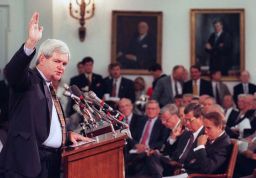Federal government shutdowns in the US are not just about money. They often happen when one political party feels that threatening to shut the federal-funding spigot is the best leverage to use in a political battle.
And in recent years, the parties have battled over a lot of things. This latest one was no. 19 since 1976.
The causes of some them may surprise you.
Immigration
January 19-22, 2018
The most recent impasse hinged on the ongoing debate over immigration. Democrats voted against a bill to fund the government because they want a fix for DACA, the program allowing some young illegal immigrants to remain in the US, before it expires in March. Republicans want border security enhancements, including funding for President Trump’s border wall, before they’ll agree to help fix DACA. After a shutdown of three days, Senate Democrats reached a compromise with Senate Republicans to reopen the government and keep it funded through February 8 in exchange for a promise to deal with DACA before then.
Obamacare and the debt ceiling
October 1-16, 2013

Republicans wanted to a way to get rid of Obamacare (some things never change) so they refused to back any spending bill that didn’t defund the Affordable Care Act. Democrats balked at that, of course, and a 16-day shutdown was on. This shutdown got tied up with the debt ceiling, which needed to be raised at about the same time, so the GOP used that as leverage, too. This one ended after the Dems stayed united, while the Republicans essentially gave in and accepted a small Obamacare concession to save face.
Federal spending
December 16, 1995-January 5, 1996
The longest shutdown in US history was, surprise, actually about money. The GOP-led Congress clashed with Democratic President Bill Clinton over the level of federal spending. The Republicans refused to OK a spending bill because they wanted the Democrats and the White House to, among other things, agree to deep cuts in Medicare and Medicaid. Plus the GOP wanted the White House to rely on Congressional Budget Office figures for their budget calculations, which weren’t as optimistic as projections from the administration’s Office of Management and Budget. The shutdown ended after 21 days, with Clinton bowing to a key Republican demand: submitting a seven-year balanced budget plan scored by the Congressional Budget Office.
November 14-18, 1995

The first of the two shutdowns that occurred during Bill Clinton’s presidency started after Clinton vetoed spending bills from the GOP-led Congress. Clinton was unwilling to accept a Republican plan that would balance the federal budget in seven years by cutting taxes; slashing Medicare, Medicaid and welfare benefits; and trimming hundreds of other federal programs. But there was another, more bizarre beginning to this one. House Speaker Newt Gingrich said he sent Clinton a tougher spending budget because he was forced to exit from the back of Air Force One while traveling with Clinton during an international trip. A short-term budget deal and a promise for more negotiations ended this impasse after just a week.
October 6-8, 1990
The first President Bush was so serious about taming the national deficit that he vetoed a spending bill that didn’t curb spending and raise revenue. The shutdown began after the House failed to override his veto. The shutdown ended after three days when a short-term spending bill was approved along with a promise by lawmakers to find more areas for deficit reduction.
Contra aid
December 19, 1987

President Reagan wanted to continue aiding the Contra rebels in Nicaragua, but Congress, run by Democrats, opposed the plan. Reagan had threatened to veto a spending bill unless the aid was included. The Democrats also waged a fight to save the Fairness Doctrine, which required broadcasters to offer opposing viewpoints on the air (although by the mid-’80s, federal agencies had stopped enforcing it). There was a brief, one-day shutdown before Reagan got his wish: the Democrats gave up on the Fairness Doctrine and agreed to send millions in nonlethal aid to the Contras.
Aircraft carrier
October 1-11, 1979

A shutdown lasting about a week and a half occurred after President Carter vetoed a defense authorization bill because it contained funds for a $2 billion nuclear-powered aircraft carrier that he said was a waste. Carter wanted Congress to rework the bill to cut money for the carrier and provide more funds for research and development and combat readiness. Carter later signed the bill, with the nuclear aircraft carrier deleted from the legislation.
Abortion
October 1-12, 1977; November 1-8, 1977; December 1-8, 1977
Legislative battles over abortion led to several government shutdowns in the fall and winter of 1977. The Senate wanted to loosen the restrictions on Medicaid funds being used for abortion – which were only in cases where the mother’s life was at stake – to also include cases of rape or incest. The House was opposed to this. The two sides couldn’t come up with a compromise by the end of the fiscal year that September, so there was a funding gap. A temporary spending bill was passed to give the House and Senate time to work out their differences, and this cycle would repeat itself until a deal was struck in December 1977 allowing Medicaid funds to be used in abortions, including in cases of rape, incest and when the mother’s health was at risk.








